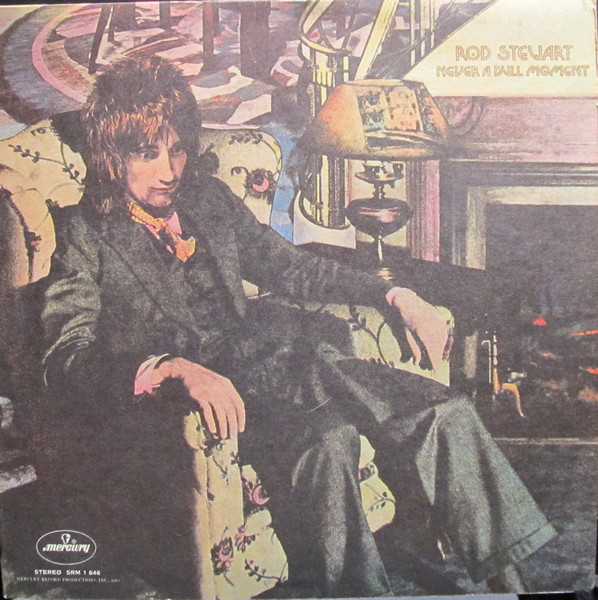

“Very similar to in many ways (which I was quite aware of),” wrote Stewart of the new hit. It recreated the feel of “Maggie May,” but with its own marvellous mood and a self-effacingly rueful lyric about a lost love. Then came “You Wear It Well,” which gave the singer another UK No.1 single and which stands as one of his greatest pieces of work. The album’s 40-second “Interludings” constituted an acoustic guitar piece with a writing credit for Ronnie Wood’s older brother Art. In his notes for the 1989 box set Storyteller, Rod described his version of “Angel” as being “played with gusto by the Faces in splendid disarray.” Side Two of the original vinyl album began with Rod’s tribute to Woody’s late friend Jimi Hendrix, with a suitably reflective remake of “Angel.” Later in the year, it would be released as a double-sided single with Stewart’s take on Jerry Lee Lewis’ “What Made Milwaukee Famous,” creating a No.4 UK hit. “The Stewart formula,” he avowed, “is broad-based enough to allow for widely varied species of old folk tunes, blues and funk numbers, hard rockers, and the melodic ‘Maggie May’ mainstream the instrumentalists have it all down, Rod himself stands ready to apply the smooth sandpaper finish, and all that’s required for another ace album is a new set of dynamics – and on Never A Dull Moment there’s no letdown in this department.” ‘When Stewart strikes, the listener gets caught’ Ken Barnes in Phonograph Record offered another highly supportive review of the album. Mandolin was by Ray Jackson, of Newcastle-upon-Tyne’s very own Lindisfarne, also a key feature of “Maggie May.” “Italian Girls” was a brawny Stewart-Wood rock workout with much to admire, including Lane’s lithe bass runs, McLagan’s stirring piano detail and Dick Powell on violin (as he was, thrillingly, on “You Wear It Well”). Stewart’s superbly sympathetic reading was underpinned by Waller’s drums and Wood’s lyrical pedal steel.
#ROD STEWART NEVER A DULL MOMENT YOUTUBE SERIES#
The album’s first cover was of Dylan’s “Mama, You Been On My Mind.” The bard wrote this song in 1964 and performed it in concert, but didn’t release his version until decades later, on 1991’s The Bootleg Series Vol.1-3 (Rare And Unreleased) 1961-1991. Wood’s nimble fretwork had uncredited horns as their counterpoint, as the narrator announced his departure for South America. That led to the splendid “Lost Paraguayos’, which showcased more of Stewart’s winningly plain-speaking lyrics, especially concerning his relationships with women. ‘True Blue’ may just be the best rocker Stewart has committed to vinyl in his last three outings.” Ron Wood and Kenny Jones produce crisp assertive lines with clever syncopations which make this tune the most cooking Faces recording for a long time.



“The hero of the cut is Ian McLagan, who contributes dazzling electric piano. “Rod writes catchy lyrics, couplets that leave a real impression because of their looseness and the way they flow naturally off the tongue. “Stewart’s unique, bright songwriting talents are highlighted with the opening ‘True Blue’,” he wrote. He composed three songs for Never A Dull Moment with his longtime pal and confidant Ronnie Wood, while the album’s best-known track, the glorious single “You Wear It Well,” was another collaboration with writer-guitarist Martin Quittenton, Rod’s foil on “Maggie May.” Elsewhere, Stewart’s range of influences was well displayed with a range of covers of such inspirations as Sam Cooke, Jimi Hendrix, and Bob Dylan.Ĭlick to load video ‘The best rocker Stewart has committed to vinyl’Īn enthusiastic fan of this opening salvo was writer Mark Leviton, who reviewed the album for the New York-based Words And Music magazine. The north London-born singer won praise for his diligence on the new album in both his songwriting and choice of outside material. When it was released, on July 21, Never A Dull Moment was an apt title. The follow-up album may have featured more than a little help from his mates, but it was again entirely self-produced. Now, after the spectacular breakthrough of Rod’s Every Picture Tells A Story album and “Maggie May” single, came further new glory. After endless toil, he had made it big beyond his wildest imaginings the year before, both as a solo artist and with his beloved Faces. The ironic album portrait may have suggested otherwise, but life was anything but boring for Rod Stewart in 1972.


 0 kommentar(er)
0 kommentar(er)
